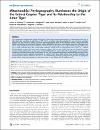Mitochondrial phylogeography illuminates the origin of the extinct caspian tiger and its relationship to the amur tiger

عرض / فتح
التاريخ
2009-01المؤلف
Driscoll, Carlos A.Yamaguchi, Nobuyuki
Bar-Gal, Gila Kahila
Roca, Alfred L.
Luo, Shujin
Macdonald, David W.
O'Brien, Stephen J.
...show more authors ...show less authors
البيانات الوصفية
عرض كامل للتسجيلةالملخص
The Caspian tiger (Panthera tigris virgata) flourished in Central Asian riverine forest systems in a range disjunct from that of other tigers, but was driven to extinction in 1970 prior to a modern molecular evaluation. For over a century naturalists puzzled over the taxonomic validity, placement, and biogeographic origin of this enigmatic animal. Using ancient-DNA (aDNA) methodology, we generated composite mtDNA haplotypes from twenty wild Caspian tigers from throughout their historic range sampled from museum collections. We found that Caspian tigers carry a major mtDNA haplotype differing by only a single nucleotide from the monomorphic haplotype found across all contemporary Amur tigers (P. t. altaica). Phylogeographic analysis with extant tiger subspecies suggests that less than 10,000 years ago the Caspian/Amur tiger ancestor colonized Central Asia via the Gansu Corridor (Silk Road) from eastern China then subsequently traversed Siberia eastward to establish the Amur tiger in the Russian Far East. The conservation implications of these findings are far reaching, as the observed genetic depletion characteristic of modern Amur tigers likely reflects these founder migrations and therefore predates human influence. Also, due to their evolutionary propinquity, living Amur tigers offer an appropriate genetic source should reintroductions to the former range of the Caspian tiger be implemented.
المجموعات
- العلوم البيولوجية والبيئية [933 items ]

